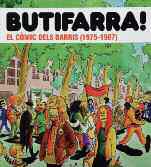 Butifarra! El còmic dels barris (1975-1987)
Butifarra! El còmic dels barris (1975-1987)
- Various authors. Materials selected and coordinated by Pepe Gálvez and Lluís Recasens
- Barcelona City Council, FAVB and Edicions Clariana, SL
- 261 pages
- Barcelona, 2015
It has been 40 years since the satirical magazine Butifarra! was founded. To celebrate, Barcelona City Council and the Barcelona Federation of Residents’ Associations (FAVB) have published a collective piece of work that does justice to one of the leading graphic magazines of that period. This wonderful volume uses a careful selection of texts and plenty of graphic material to recapture the memory of a medium, and a team of cartoonists and comic writers who shared their talent with the city’s neighbourhood social movements during the years of political transition to democracy, continuing the tradition of the Catalan satirical publications that were cut short by the Spanish Civil War and dictatorship.
The first section features several articles situated in different contexts: the most notable precedents in the Catalan satirical press, by journalist and art critic Josep M. Cadena; the adult comic’s first steps, in an article by historian and comic writer Antoni Guiral; graphic humour in Spain at the end of Francoism, according to critic and comic writer Pepe Gálvez; and the social and political context of 1975, explained by Carles Prieto, former FAVB chair.
This was a time when Barcelona experienced a boom in “the residents’ associations movement – a reflection of the reappearance of popular social movements and, at the same time, of the urban struggles that help to reclaim spaces and encourage participation,” explains Andrés Naya. It was also a time when artists, writers and residents “were on the same side of the divide” and the comic artists themselves, in the case of Butifarra!, work as journalists, but always with graphic material as their protagonist. “Comics were not just for entertainment; they also served a political purpose. They were and are a way to communicate, with numerous possibilities,” writes Alfonso López, the magazine’s creator and maintainer.
A second section explains the different publication phases, a history full of changes, vicissitudes and business upheavals. This is where we find the names of a large number of authors who criticised the specific situations of Barcelona’s neighbourhoods through Butifarra! This is another way in which justice is served, as the comics, drawings and texts were often kept anonymous in order to avoid reprisals.
As a result, in the first phase, Butifarra! was a comic to inform and stir up the neighbourhoods, a platform for associations and grassroots organizations to express themselves. With the advent of the democratically-formed city councils and parliament, the magazine wanted to become part of the political debate and establish its own voice. The magazine format was abandoned in 1979 and El urbanismo feroz [Savage urban development] was published, the first in a series of quarterly albums revolving around a single theme. The new format moved away from direct politics and dealt with everyday capitalism. The final album, El patio trasero [The back patio], appeared in 1987. Over time, the magazine’s team had become a kind of agency available to different entities who were pushing to improve the population’s living conditions. The end of the book features a review of what are known as “the children of Butifarra!” – publications that were born out of its spirit. As the book says, “the history of Butifarra! lives on, talking about a time and a reality”.


